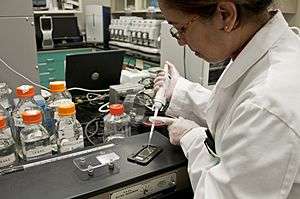Toxicology facts for kids
Toxicology is the study of how chemicals can affect living things. It's like being a detective for poisons! Scientists who study toxicology are called toxicologists. They use their knowledge of biology, chemistry, medicine, and how medicines work to understand how different substances can harm us. A big part of their job is figuring out how much of a substance it takes to cause a problem.
Sometimes, a chemical isn't harmful on its own. It only becomes toxic after our body changes it. For example, our liver has special helpers called enzymes. These enzymes can change chemicals, sometimes making them harmful. A common medicine called paracetamol can become toxic in the liver if too much is taken.
Everyone's body is a little different because of their genes. These differences can change how our liver enzymes work. This means a substance might be more harmful to one person than to another. Also, some chemicals only become toxic when they are mixed with other chemicals.
Contents
How Scientists Measure Toxicity
Scientists have ways to measure how toxic a substance is. This helps them understand how much of a chemical might be dangerous.
LD50 Test
The LD50 test helps find the average amount of a substance needed to kill half of the animals being tested. This is often done with rats to help understand how a substance might affect humans.
Fixed Dose Procedure
The Fixed Dose Procedure is another way to test how toxic a substance is when swallowed. It uses fewer animals and causes less suffering than the LD50 test, while still giving important information.
Related pages
- In vitro toxicology
- Toxicity
Images for kids
See also
 In Spanish: Toxicología para niños
In Spanish: Toxicología para niños



